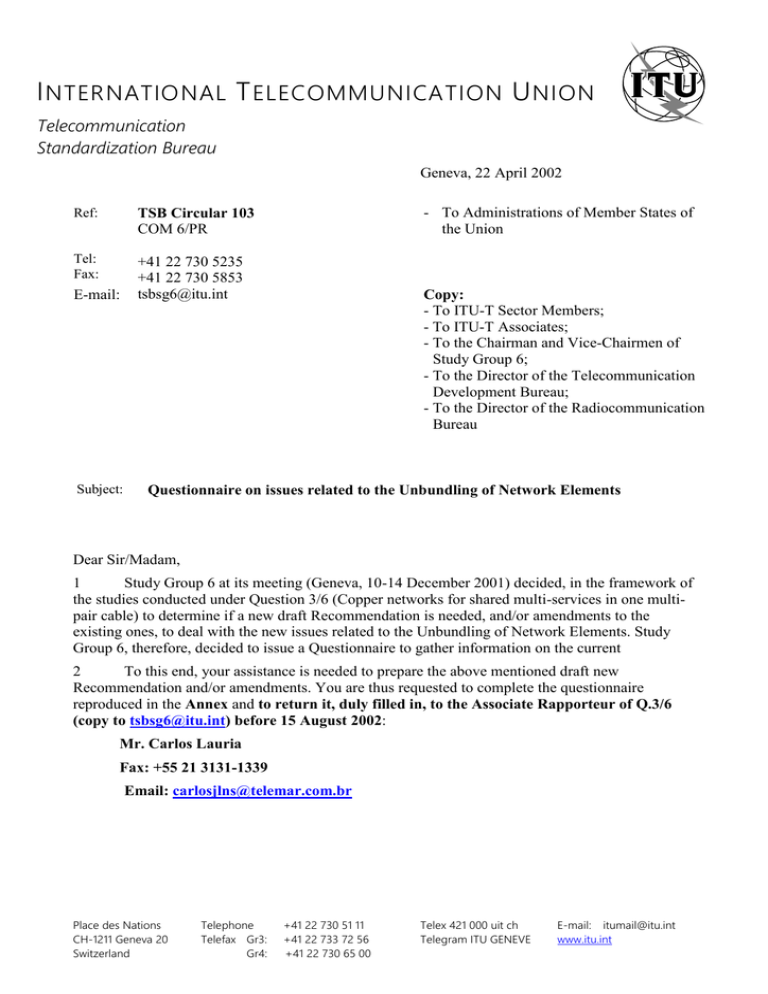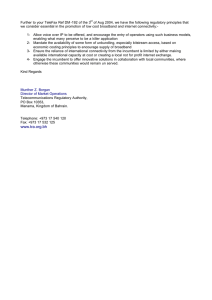I T U NTERNATIONAL
advertisement

I NTERNATIONAL T ELECOMMUNICATION U NION Telecommunication Standardization Bureau Geneva, 22 April 2002 Ref: TSB Circular 103 COM 6/PR Tel: Fax: +41 22 730 5235 +41 22 730 5853 tsbsg6@itu.int E-mail: Subject: - To Administrations of Member States of the Union Copy: - To ITU-T Sector Members; - To ITU-T Associates; - To the Chairman and Vice-Chairmen of Study Group 6; - To the Director of the Telecommunication Development Bureau; - To the Director of the Radiocommunication Bureau Questionnaire on issues related to the Unbundling of Network Elements Dear Sir/Madam, 1 Study Group 6 at its meeting (Geneva, 10-14 December 2001) decided, in the framework of the studies conducted under Question 3/6 (Copper networks for shared multi-services in one multipair cable) to determine if a new draft Recommendation is needed, and/or amendments to the existing ones, to deal with the new issues related to the Unbundling of Network Elements. Study Group 6, therefore, decided to issue a Questionnaire to gather information on the current 2 To this end, your assistance is needed to prepare the above mentioned draft new Recommendation and/or amendments. You are thus requested to complete the questionnaire reproduced in the Annex and to return it, duly filled in, to the Associate Rapporteur of Q.3/6 (copy to tsbsg6@itu.int) before 15 August 2002: Mr. Carlos Lauria Fax: +55 21 3131-1339 Email: carlosjlns@telemar.com.br Place des Nations CH-1211 Geneva 20 Switzerland Telephone Telefax Gr3: Gr4: +41 22 730 51 11 +41 22 733 72 56 +41 22 730 65 00 Telex 421 000 uit ch Telegram ITU GENEVE E-mail: itumail@itu.int www.itu.int -2- I rely on your cooperation in making sure that your replies are as accurate as possible and reach the Associate Rapporteur, above mentioned, before the deadline. Yours faithfully, H. Zhao Director of the Telecommunication Standardization Bureau Annex: 1. ITU-T\BUREAU\CIRC\103E.DOC 31.05.16 -3- QUESTIONNAIRE ON: “Issues related to the Unbundling of Network Elements” 1. Objective and instructions As stated on the “Report of the second meeting of Study Group 6 - Outside Plant (Geneva, 10-14 December 2001)”, a major issue facing Q.3/6 in this Study Period is addressing the adequacy of existing and future copper cable to guarantee performance in high bit rate systems in the new “shared facility” environment. This questionnaire is intended to collect technical information related to the Unbundling of Network Elements, particularly the unbundling of the local loop. The answers will help to prepare a detailed workplan on the theme, containing the actions that will have to be made by SG6 members to amend some Recommendations or to build a new one if necessary. Study Group 6 is responsible for the part of the network most affected by the unbundling of network elements and some aspects may address issues covered by other questions from SG-6. On the next meeting, it will be decided how to deal with this likely situation. Regulators, policymakers, operators and manufacturers from one country are encouraged to produce only one consolidated full filled questionnaire. If it’s not possible, we can handle more than one per country as well. Even if unbundling is not regulated in the country yet, there are questions that can be answered and will be valuable to the work. To ease the understanding of the questions and have consistent answers, a brief section entitled “Concepts and definitions” was included. It lists also all the abbreviations used in this questionnaire. Please, fill in the blank spaces of the questions and all the lines starting with the “” symbol. The answers can be pictures, drawings, descriptions, flowcharts, checklists, “Not Available – N/A”, etc. Many questions have instructions in the format “(instruction)”. In any case, if further explanations are needed to produce better answers, feel free to contact the Associate Rapporteur responsible for the questionnaire, as listed in the first page. We thank you very much in advance for your efforts to give reliable and useful answers to the questionnaire. ITU-T\BUREAU\CIRC\103E.DOC 31.05.16 -4- 2. Concepts and definitions 2.1 What is Unbundling of Network Elements In many countries, recent laws permit that Other Licensed Operators (OLOs) compete with the traditional incumbent operator. This creates a new environment, where a company have to install, operate and maintain its network having in mind that other networks are just beside it, or even at the same location. Also, regulators from a number of countries understand that some parts of the networks should be shared by the operators, in a transparent process to the users. This is called Unbundling of Network Elements or, shortly, unbundling. Some new issues have to be taken into account to allow the accommodation of those operators at the same space without problems. To guarantee a stress-free environment for operators, legal and administrative solutions must be followed by the correct technical solutions, which assure the network integrity, the easy use of equipment and the access security. Although a number of network elements (NE) can be defined by the regulators, this questionnaire is focused in one specific, the local loop, because the others don’t seem to be on the scope of SG6. There are some different ways to have unbundled NEs, and some of them are described on the following items. Collocation is also listed, because it’s intrinsically related to unbundling. A crucial aspect is the network evolution (e.g., FTTC and FTTH), because it may be difficult to change its topology maintaining the services already provided by OLOs on the same elements. Section 6 refers to optical fibre networks and was included because, although still unusual, these networks can be unbundled too. In this questionnaire, some questions are related to physical access, equipment connection, electromagnetic interference and security. Sometimes the issues do not depend on the existence of unbundled elements, because they arise when an operator starts to provide xDSL services on its own network. This questionnaire can be answered even if there’s no unbundling in a country where xDSL systems are in use. ITU-T\BUREAU\CIRC\103E.DOC 31.05.16 -5- 2.2 Types of unbundling and collocation (if different in your country, fill item 3.4) The main types of unbundling of the local loop are outlined in the figure and described in the next items. Collocation is detailed in item 2.2.4. The abbreviations are listed in item 2.3. INCUMBENT’S CENTRAL OFFICE Local Loop Higher band Local Loop M D F Local Loop S p l i t t e r s Full unbundling OLO network DSLAM (OLO) Line sharing Collocation area Bit stream Lower band Higher band DSLAM (incumbent) Lower band Incumbent network 2.2.1 Full unbundling: This is the original unbundling configuration. OLO has direct access to the twisted copper pair and can use the pair to provide any service allowed by the regulator (typically xDSL, but sometimes voice), but not interfering with other services provided in the same cable. Many times it’s associated with collocation to OLO’s equipment (DSLAM). 2.2.2 Line sharing: voice service (POTS/PSTN) and data transmission service are provided using the same copper pair. Voice is provided in the lower frequency band (usually by the incumbent), and data transmission in the higher frequency band. Both operators must physically access the pair, and the OLO’s equipment use to be housed in a collocation area inside the incumbent’s central office building. Splitters have to be installed both in the customer’s premises and in the central office, to guide the signals suitably to the computer and to the telephone terminal (and to their correspondent networks). 2.2.3 Bitstream: this is a higher layer unbundling, with less physical contact between incumbent and OLO. The incumbent operator installs and operates the network from the customer premises to the DSLAM, providing a bundle of channels (usually STM-1) to the OLO. Usually it’s associated with a transportation service (back haul) to the nearest OLO’s PoP. 2.2.4 Collocation: many times, the OLO will want to (or must) rent space in the incumbent central office to install its own equipment. Figure in item 2.2 shows a typical collocation area inside the CO, with the OLO’s DSLAM installed on it. Due to an eventual lack of suitable space, there are some different kinds of collocation. If some OLOs want to (or must) use the same room (or cage), it is called “shared collocation”. A “virtual collocation” takes place when the DSLAM is bought by the OLO, but is installed and operated by the incumbent. If there’s no space inside the building, equipment may be housed externally, the “remote collocation”, in other building or in containers located in ITU-T\BUREAU\CIRC\103E.DOC 31.05.16 -6- parking lots. A special situation, described in the next item, is when an outdoor remote DSLAM is needed. 2.2.5 Outdoor remote DSLAM: This is the toughest situation, requiring critical technical solutions. When a network has remote concentration (or switching) elements in cabinets along the copper loops, it may be necessary to connect those elements to the OLO’s network. Usually there is no space for collocation and the elements are in an aggressive environment. This connection can be a very challenging task, as the equipments of both operators may have to be able to accept external tie cables and/or have space inside to install the OLO’s DSLAM. Other solutions may include compatible printed circuit cards inserted in the incumbent’s remote equipment and the transport of the signals by the incumbent to the OLO’s nearest PoP. The physical access is another issue that has to have a convenient solution, because of security matters. Special attention should be given to the signals inserted along the cable from the central office to the costumer location. They may interfere in the other services already provided in the same cable, because they can be stronger than the others at the insertion point. 2.2.6 Sub-loop: there are special circumstances, usually in long copper loops, where parts of the local loop are rented apart of each other. The individual sub-loop elements that use to be available are feeders, distribution and concentration elements. Problems and solutions are similar to those listed for the outdoor remote DSLAM. 2.3 Abbreviations This section only explains what the abbreviations stand for when used in this questionnaire, as listed in the ITU’s SANCHO database (http://www.itu.int/sancho). The meaning of each term can be found in additional documentation from ITU or other appropriate standardization body. 2B1Q ADSL AMI CAP CO DSLA E1/T1 EMC EMI FTTC FTTH HDB3 HDF HDSL ISDN MDF NE NTP ODF OLO PoP POTS 2 Binary 1 Quaternary line code Asymmetric Digital Subscriber Line Alternate Mark Inversion code Carrierless Amplitude and Phase modulation Central Office Digital Subscriber Line Access Multiplexer M 2 Mbps / 1.5 Mbps digital signal level 1 Electro Magnetic Compatibility Electro Magnetic Interference Fibre To The Curb Fibre To The Home High Density Bipolar 3 code Handover Distribution Frame High bit rate Digital Subscriber Line Integrated Services Digital Network Main Distribution Frame Network Element Network Termination Point Optical Distribution Frame Other Licensed Operator Point of Presence Plain Old Telephone Service ITU-T\BUREAU\CIRC\103E.DOC 31.05.16 -7- PSTN SDSL SHDSL SSDSL STM UADS L UNE VDSL xDSL 3. Public Switched Telephone Network Symmetric Digital Subscriber Line Single pair High speed Digital Subscriber Line Synchronized Symmetrical Digital Subscriber Line Synchronous Transport Module Universal Asymmetric Digital Subscriber Line Unbundling of Network Elements Very high-speed Digital Subscriber Line Any of the various types of Digital Subscriber Line systems Regulation issues Different regulation can lead to different technical solutions and, as the implementation timing of the unbundling regulation varies from country to country, some questions are included here to guarantee the compatibility of the received answers. If some items do not apply to a country or applies with a different meaning, please list this information on item 3.4. Many questions can be answered, even if unbundling is not implemented yet. 3.1 Timeline to the unbundling implementation (fill with the dates established by the regulators to start each type of unbundling, in the past or in the future, or check the appropriate column) TYPE OF UNBUNDLING OPTIONAL MANDATORY NOT TO BE USED [ ] N/A* Full unbundling Line sharing / / / / [ ] / / / / [ ] [ ] Bitstream / / / / [ ] [ ] Collocation / / / / [ ] [ ] Sub-loop / / / / [ ] [ ] Optical network elements / / / / [ ] [ ] * Information not available 3.2 Number of telecom operators sharing the same network element (check only one option) NUMBER OF OPERATORS None (no unbundling) [ ] Two [ ] Three [ ] Four [ ] More than four [ ] ITU-T\BUREAU\CIRC\103E.DOC 31.05.16 -8- 3.3 Shared access to Subscribers and Network Facilities databases (check only one option) SHARED DATABASES None [ ] Subscriber [ ] Network facilities [ ] Both [ ] 3.4 Other regulation information (include any other useful information related to regulation) 4. Topology 4.1 Where in the network the connection between incumbent and OLO equipments can be done (detail where it’s mandatory or optional). 4.1.1 Indoor 4.1.2 Outdoor 5. Technical issues 5.1 Telecom operators relationship 5.1.1 Security matters (list the main rules to deal with each theme) 5.1.1.1 Physical 5.1.1.2 Fire 5.1.1.3 Electrical 5.1.1.4 EMC/EMI ITU-T\BUREAU\CIRC\103E.DOC 31.05.16 -9- 5.1.2 Databases access: consults, insertions and modifications (check all that apply) TYPE OF ACCESS Made by the incumbent [ ] Made by OLO on incumbent sites [ ] Made by OLO via Web interface [ ] Made by OLO via other remote interface (e.g., dial up) [ ] 5.1.3 Interfacing operators in connection locations (list the main technical solutions adopted in each part of the network) 5.1.3.1 MDF 5.1.3.2 Cabinet or closures 5.1.3.3 Aerial 5.1.3.4 Buried 5.1.3.5 Manhole 5.1.3.6 Costumer premises 5.2 Cable spectrum management matters 5.2.1 Cable characteristics related to high-speed data transmission. (split item if more than one per category) 5.2.1.1 Aerial 5.2.1.2 Duct ITU-T\BUREAU\CIRC\103E.DOC 31.05.16 - 10 - 5.2.1.3 Buried 5.2.1.4 Internal (except tie cables) 5.2.1.5 Tie cables (internal and external) 5.2.2 Types of connectors used in the cables (dry, jelly filled, other) 5.2.3 Copper pair qualification (procedures, solving conflicts, etc) 5.2.4 Copper pair conditioning (procedures, solving conflicts, etc) 5.2.5 Per cable occupation ratio (number of pairs used for each technology, divided by the total number of pairs of the cable. If possible, list values for short, medium and long length loops) 5.2.5.1 ISDN 5.2.5.2 HDSL 5.2.5.3 ADSL (G.lite; full) 5.2.5.4 SDSL 5.2.5.5 E1/T1 5.2.5.6 Other (SHDSL, SSDSL, etc. Describe) ITU-T\BUREAU\CIRC\103E.DOC 31.05.16 - 11 - 5.2.6 Technologies in use (number of lines in use for each technology) 5.2.6.1 PSTN - # of lines 5.2.6.2 Pair gain systems - # of physical lines; # of virtual lines; frequency range; protocol (e.g., AMI) 5.2.6.3 ISDN - # of lines; protocol 5.2.6.4 xDSL - # of lines; type (HDSL; ADSL; SDSL, etc); protocol (e.g., HDB3, 2B1Q; CAP) 5.2.6.5 E1/T1 - # of lines 5.2.6.6 Other (describe) 5.2.7 Simultaneous technologies allowed (xDSL; ISDN, E1/T1, pair gain, PSTN, other) 5.2.8 Number of unbundled loops using full unbundling, line sharing and bitstream (# of lines per type of unbundling; % of total installed lines) 5.2.9 Installation and maintenance (for more than one operator in the same network element) 5.2.9.1 Procedures 5.2.9.2 Time limits 5.2.9.3 Responsibilities 5.2.10 Network integrity assurance (QoS, confidentiality and reliability obligations) ITU-T\BUREAU\CIRC\103E.DOC 31.05.16 - 12 - 5.2.11 Implementation of new technologies and topologies (network evolution and its associated issues, e.g., FTTH and FTTC) 5.2.12 Proceedings to solve conflicts (when an operator do not agree with one other) 5.3 Collocation issues 5.3.1 Topologies adopted (where in the network collocation is allowed.) 5.3.1.1 Inside the central office (typical, shared, virtual) 5.3.1.2 Outside the central office (remote, outdoor) 5.3.2 Technical solutions (how equipments are physically placed and connected) 5.3.2.1 Inside the central office 5.3.2.2 Outside the central office 5.3.3 Other (describe) 6. Optical networks Please, if unbundling of optical network elements is allowed, answer to the next questions. Otherwise, jump to the next section. ITU-T\BUREAU\CIRC\103E.DOC 31.05.16 - 13 - 6.1 Cross connections or demarcation points between separated networks When operators have physically separated networks, they need to connect these networks at certain locations. These connections are often called demarcation points or network cross connections. 6.1.1 Where networks are physically connected: at the ODF; in outdoor nodes (closures, cabinets etc.); at the customer connection box; other. 6.1.2 What method of fibre connection is to be used: permanent splices (fusion or mechanical); optical connector; other. 6.2 Sharing optical fibres and cables 6.2.1 If fibres are shared, specify: how the network architecture is designed to allow network sharing; if fibres are leased to OLOs, how many different OLOs may share the same cable; etc. 6.2.2 If ribbonised fibres are used, specify: if fibres are assigned ribbon by ribbon; if ribbons are shared fibre by fibre; if bandwidth is shared in the same fibre within the ribbon (e.g. at different wavelengths); other. 6.2.3 If cables are shared, specify: if fibres are shared within the same cable; if separate cable elements are assigned per operator (e.g. assign fibres tube by tube); if fibres are shared in the same cable element (e.g. share fibres in the same loose tube); if bandwidth is shared in the same fibre; (e.g. at different wavelengths or bands per operator); other. 6.3 Sharing infrastructure 6.3.1 Indoor: there are separate rooms inside building; operators use the same room, but separated Optical Distribution Frames (ODF); use shared access to the same ODF; use shared access to the same shelves within an ODF; other. 6.3.2 Civil infrastructure: operators use separate ducts, handholes and manholes; separate ducts, shared manholes/handholes; shared ducts; other. ITU-T\BUREAU\CIRC\103E.DOC 31.05.16 - 14 - 6.3.3 Outdoor nodes: access to network nodes by other operators is not allowed; operators use shared access to closures/enclosures; use access to circuits of different operators will be physically separated and restricted; circuits are physically separated, but there is no restriction for accessing the different circuits; fibres of different operators may reside on the same organiser trays or element; other. 6.4 Other information related to unbundling of optical fibre network elements 7. Reported problems (please, list the main problems found and, if solved, its solutions) 7.1 8. Additional information (any other relevant information) 8.1 ___________________ ITU-T\BUREAU\CIRC\103E.DOC 31.05.16


